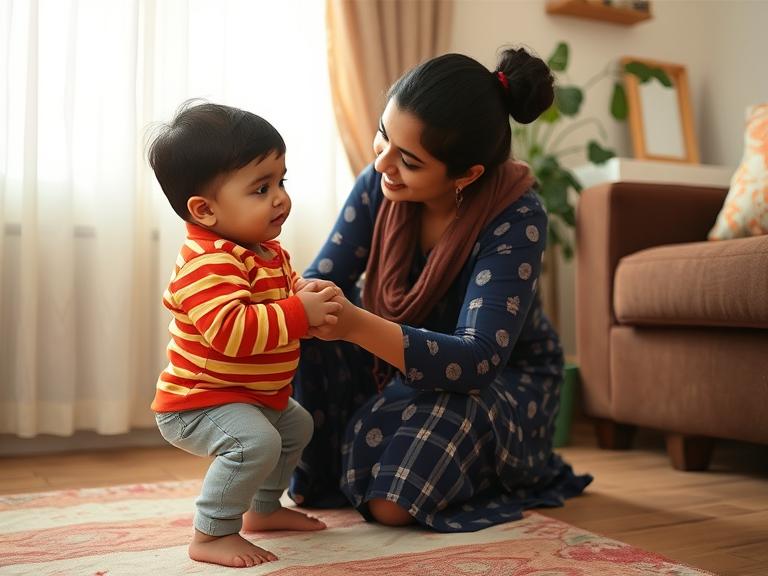Do you ever wish there was a calmer, kinder way to guide your child? Many parents feel stuck in a cycle of yelling, time-outs, and guilt. If you’ve wondered whether there’s a better way, gentle parenting might be the answer you’re looking for.
Gentle parenting means raising your child with empathy, respect, and clear boundaries — without harsh punishments. In this guide, you’ll learn exactly what gentle parenting is, its four core principles, easy steps to start, myths to ignore, and real-life stories.
Let’s explore how you can start gentle parenting today.
What Is Gentle Parenting?
Gentle parenting is an approach where you guide your child with kindness, understanding, and clear rules. Unlike strict, authoritarian parenting — which often relies on fear or punishment — gentle parenting encourages parents to respond calmly and teach instead of scolding.
Example: Instead of yelling at a toddler’s tantrum, you pause, name their feelings, and help them calm down with love and limits.
The 4 Core Principles of Gentle Parenting
1. Empathy
Empathy is the heart of gentle parenting. It means trying to see the world through your child’s eyes. When you understand their feelings, you respond with calm instead of anger.
Example: If your toddler cries because playtime is over, say, “I see you’re sad playtime is finished. Let’s say goodbye to your toys and get ready for dinner together.”
2. Respect
Discipline means teaching — not punishing. Gentle parenting uses natural consequences and calm guidance to show children how to behave.
Example: If your child throws food, say calmly, “Food is for eating, not throwing. If you throw again, lunch will be over and we’ll clean up together.”
3. Understanding Boundaries
Gentle parenting is not permissive parenting. Children still need clear rules — bedtime, screen limits, sharing — but the rules are explained with patience, not fear.
Example: If screen time is over, say, “Screen time is finished. Let’s play a board game instead.”
4. Positive Discipline
Discipline means teaching — not punishing. Gentle parenting uses natural consequences and calm guidance to show children how to behave.
Example: If your child throws food, say calmly, “Food is for eating, not throwing. If you throw again, lunch will be over and we’ll clean up together.”
Benefits of Gentle Parenting
– Builds a deep, respectful parent-child bond
– Helps children learn to manage big emotions
– Reduces shouting, power struggles, and guilt
– Encourages children to grow into kind, confident adults
– Creates a calmer, happier family atmosphere
How to Start Gentle Parenting (Step-by-Step)
Step 1 — Reflect on Your Own Parenting Style
Before changing how you parent, notice why you react the way you do. Many parents shout or punish because that’s how they were raised. Others react from stress, exhaustion, or lack of support.
Start with a simple journal. For a week, note moments when you lost your patience or handled a situation well. Ask yourself:
- What triggered me?
- How did my child feel?
- What could I do differently next time?
This reflection helps you break old patterns and respond more calmly next time. Remember, awareness is the first step to change.
Step 2 — Start Small: One Habit at a Time
Don’t overwhelm yourself by trying to overhaul everything overnight. Gentle parenting is a journey, not a quick fix. Pick just one habit to practise this week.
Examples of easy starting points:
- Use a calm tone when giving instructions.
- Give your child choices: “Do you want to wear the red shirt or the blue one?”
- Kneel down to your child’s eye level when talking.
- Add simple warnings: “In five minutes, we’ll switch off the TV.”
Repeat this one habit daily until it feels natural — then add another.
Step 3 — Use Gentle Discipline Techniques
Discipline in gentle parenting is not about punishments but about teaching what to do instead. Start using simple tools that help your child learn better choices.
Try these:
- Choices & consequences: “If you throw the toy again, I’ll need to put it away until tomorrow.”
- Natural consequences: If your child spills water on purpose, have them help clean up.
- Redirection: If they hit, hold their hands gently and say, “Hands are for hugging. Let’s find another way to show how you feel.”
- Praise: Celebrate small wins: “Thank you for packing away your toys!”
Step 4 — Stay Calm During Tantrums
Tantrums test every parent’s limits, especially when you’re tired or stressed. The key is to stay calm — your child’s big feelings need your steady presence.
Try this when a tantrum hits:
- Get down to their level.
- Avoid shouting over their cries.
- Gently name the feeling: “You’re upset because you wanted more playtime.”
- Offer comfort, not lectures. A calm hug often works better than words.
- Wait until they’re calm to talk about what happened.
Over time, children learn that emotions are okay and that you’ll always be their safe space.
Step 5 — Keep Learning
Gentle parenting is not about being perfect — it’s about growing alongside your child. Some days you’ll shout, some days you’ll be patient — both are part of real life.
Keep feeding your parenting journey:
- Read books about gentle parenting.
- Listen to podcasts or watch videos.
- Join online communities or parenting groups.
- Talk with your partner so you’re on the same page.
The more you learn, the more tools you’ll have to handle everyday parenting calmly.
Common Myths About Gentle Parenting
Myth 1: Gentle Parenting Is Permissive
Many people think gentle parenting means letting kids do whatever they want. But this is a misunderstanding. Gentle parenting doesn’t remove rules — it explains them kindly and consistently.
Children still hear “No”, they just hear why it’s a “No”. For example, instead of shouting, “Stop jumping on the sofa!” you say, “Sofas are for sitting. Jumping can break them. Let’s jump on the floor or go outside.”
The boundary stays firm, but your tone is respectful. This teaches kids self-control and respect for limits without fear.
Myth 2: Gentle Parenting Spoils Kids
Another myth is that gentle parenting creates entitled or spoiled children who can’t handle life’s challenges. In reality, kids raised with gentle parenting learn important life skills — like problem-solving, empathy, and taking responsibility for their actions.
When you replace fear-based discipline with clear, calm teaching, your child understands how their actions affect others. For example, if they break a toy on purpose, they help clean up and don’t get a replacement immediately — they learn natural consequences.
Spoiling happens when children never hear “No” or when parents rescue them from every mistake. Gentle parenting does neither — it guides kids kindly while letting them feel the impact of their choices.
Myth 3: Gentle Parenting Is Too Soft for Real Life
Some critics say gentle parenting is unrealistic — that it won’t work in the “real world” where kids face rules, teachers, or bosses. But it actually prepares children better for real life because they practise healthy communication, emotional control, and respect for rules at home.
Instead of obeying out of fear, children learn why rules matter and how to follow them willingly. For example, if bedtime is at 8 PM, you calmly remind them and stick to it, even if there’s pushback. You’re kind, but you’re not a pushover.
Children raised this way grow up to handle school, friendships, and work relationships with more confidence and respect.
Real-Life Gentle Parenting Examples
Example 1: Handling a Toddler’s Aggression
“When my three-year-old son, Aarav, hit his baby sister out of jealousy, my first instinct was to yell. But instead, I took a deep breath, knelt to his level, held his hands gently, and said, ‘I see you’re upset your sister got my attention first. Hitting hurts. Let’s use words instead. Can you show me how you feel with your words?‘

Over time, he learned to say, ‘Mama, I want you too,’ instead of hitting. It didn’t happen overnight, but staying calm showed him a better way.”
Example 2: Bedtime Battles Turned Calm
“Bedtime was always a nightmare in our house. My daughter, Riya, would cry and stall for hours. I realised I was threatening punishments instead of connecting with her. One night, I tried something different — we added a 5-minute cuddle time and a simple bedtime story. I also gave her a choice: ‘Do you want the teddy or the bunny tonight?’

The power struggles slowly melted away. Now bedtime is our favourite bonding moment instead of a nightly fight.”
Example 3: Public Tantrum Without the Guilt
“Once, my toddler had a massive meltdown at the grocery store. People stared. My old self would have dragged him out angrily. Instead, I sat on the floor beside him and said softly, ‘You’re sad we can’t get that candy today. I know it’s hard.’

He screamed for a few more minutes but calmed down when he felt heard. We left the store peacefully. Did people judge? Maybe. But my child learned I was his safe place, even in public.”
These everyday moments show that gentle parenting doesn’t mean chaos — it means choosing calm connection in the mess. It’s not perfect parenting; it’s parenting with patience, clear limits, and empathy.
Final Tips to Make Gentle Parenting Work
Gentle parenting isn’t about being perfect — it’s about trying your best every day. Some days you’ll stay calm, other days you’ll lose your patience. That’s okay. Say sorry, reconnect, and try again.
Hold clear but kind boundaries. Children feel safer when they know you mean what you say, even when they don’t like it.
Add small daily moments that build trust — a bedtime story, an extra hug, or five quiet minutes together.
Talk to your partner, family, or caregivers so everyone understands your gentle approach.
Keep learning and celebrate small wins. A calm word today can shape a kinder tomorrow.
You’ve got this — one gentle step at a time.
Frequently Asked Questions (FAQs)
Can gentle parenting really work for stubborn kids?
Yes! Gentle parenting works well for strong-willed children because it combines clear limits with kindness. Instead of punishing stubborn behaviour, you guide them calmly, explain choices, and help them understand consequences. Over time, they learn to listen and respect rules without fear.
Is gentle parenting realistic when I’m busy or stressed?
Absolutely. Gentle parenting doesn’t mean you never get frustrated — it’s about small, daily choices. Even busy parents can pause, take a breath, and speak kindly. Simple habits like giving choices or explaining rules calmly make everyday moments smoother.
What if my partner doesn’t follow gentle parenting?
It’s common for parents to have different styles at first. Start small: share what you’re learning and show how it helps at home. Stay calm, lead by example, and share resources. Many partners become supportive once they see the positive changes.
Does gentle parenting mean there are no consequences?
No — it means the consequences are natural and respectful, not harsh or scary. For example, if a child throws a toy, they help clean it up and may lose it for the day. They still learn about responsibility and limits, but without fear.
How can I stay calm when my child misbehaves?
It’s hard sometimes! Try to pause, breathe deeply, and remind yourself that your calm teaches your child how to handle big feelings. If you slip up and yell, it’s okay — apologise and reconnect. Staying calm takes practice, not perfection.
What if my child doesn’t listen at all?
Listening skills grow with time. Gentle parenting works when you stay consistent with clear rules, choices, and consequences. Children may test boundaries, but when they feel heard and respected, they’re more likely to cooperate over time.
Is gentle parenting only for toddlers and young kids?
No! Gentle parenting works for all ages, including older kids and teens. Older children understand calm explanations even better. Respectful communication, clear limits, and empathy help repair power struggles at any age.
What if grandparents use harsh discipline?
Many grandparents use old-school methods. Calmly explain your approach and why you avoid shouting or punishment. Share examples and invite them to try your way. Be patient — change takes time, but consistency helps your child know what to expect.




3 thoughts on “Gentle Parenting: What It Is and How to Start”